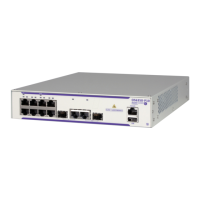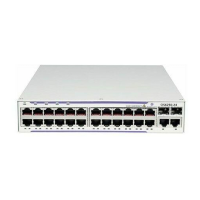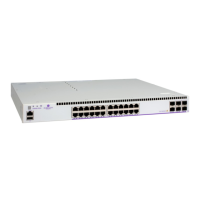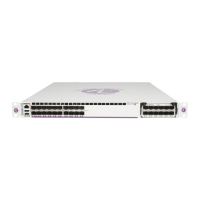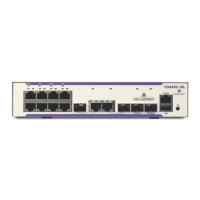Configuring BFD BFD Overview
OmniSwitch AOS Release 8 Network Configuration Guide December 2017 page 20-10
BFD Overview
Detecting communication failures as soon as possible is the first step in any network recovery process;
until a failure is detected, network convergence can’t begin. By rapidly detecting failures, BFD enables
faster convergence of routing protocols particularly on shared media such as Ethernet.
The BFD protocol is very similar to the widely-used Hello mechanisms prevalent in a majority of routing
protocols, with the exception that BFD tests bidirectional communication links, has smaller packets, and is
focused exclusively on path-failure detection. BFD can also be less CPU-intensive in routers with
distributed architecture because unlike routing protocol Hello packets, BFD packets can be processed on
the interface modules rather than the control plane.
BFD protocol is a fairly simple Hello protocol designed to provide fast forwarding path failure detection
that can be enabled at the interface and routing protocol levels. It helps in the verification of forwarding
plane-to-forwarding plane connectivity (including links, interfaces, tunnels). It allows semantic separation
of forwarding plane connectivity and control plane connectivity. BFD is a single mechanism that works
independently of underlying media, data, and network protocols. It can be associated with any routing
protocol running between two systems. Moreover, it requires no changes to the existing protocols.
This implementation of BFD can be associated with tracking of next hops with the BGP, OSPF, VRRP
and other static route protocols.
Benefits of Using BFD For Failure Detection
It is more advantageous to implement BFD rather than reduce timer mechanisms for routing protocols due
to the following reasons:
• BFD can detect failures in milliseconds without having to fine-tune routing protocol Hello timers.
• BFD is not tied to any particular routing protocol. As a result, BFD provides a generic and consistent
failure detection mechanism for OSPF, BGP, VRRP Remote Tracking, and static routes.
• BFD is less CPU-intensive than reduced timer mechanisms for routing protocols.
How the BFD Protocol Works
A BFD session must be explicitly configured between two adjacent systems. Once BFD has been enabled
on the interfaces and at the appropriate Layer 3 routing protocol level, a BFD session is created for the
adjacent systems and BFD timers are negotiated between these systems.
The BFD protocol does not have a neighbor discovery mechanism to detect neighboring systems;
protocols that BFD services notify BFD of devices to which it needs to establish sessions. For example, an
OSPF implementation can request BFD to establish a session with a neighbor discovered using the OSPF
Hello protocol.
Once a session is established, BFD peers—neighboring systems sharing a BFD interface—begin sending
BFD control packets to each other over the bidirectional forwarding path. The packets are transmitted
periodically at the negotiated rate. The BFD control packets function in a similar manner to that of an IGP
Hello protocol, except at a more accelerated rate.
Each time a BFD control packet is successfully received through a BFD interface, the detect-timer for that
session is reset to zero. As long as the BFD peer systems receive the control packets from each other
within the negotiated time interval [(Detect Time Multiplier) * (Required Minimum Rx Interval)], the
BFD session remains up. Any routing protocol associated with BFD maintains its adjacencies. BFD
continues its periodic transmission of control packets at the negotiated rate.

